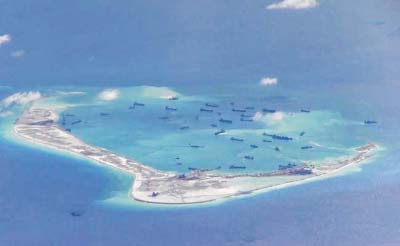
Reuters, Washington :
The United States has seen Chinese activity around a reef that China seized from the Philippines nearly four years ago that could be a precursor to more land reclamation in the disputed South China Sea, the US Navy chief said on Thursday.
The head of US naval operations, Admiral John Richardson, expressed concern that an international court ruling expected in coming weeks on a case brought by the Philippines against China over its South China Sea claims could be a trigger for Beijing to declare an exclusion zone in the busy trade route.
Richardson told Reuters the United States was weighing responses to such a move.
He said the US military had seen Chinese activity around Scarborough Shoal in the northern part of the Spratly archipelago, about 125 miles (200 km) west of the Philippine base of Subic Bay.
“I think we see some surface ship activity and those sorts of things, survey type of activity, going on. That’s an area of concern … a next possible area of reclamation,” he said.
Richardson said it was unclear if the activity near the reef, which China seized in 2012, was related to the pending arbitration decision.
He said China’s pursuit of South China Sea territory, which has included massive land reclamation to create artificial islands elsewhere in the Spratlys, threatened to reverse decades of open access and introduce new “rules” that required countries to obtain permission before transiting those waters.
He said that was a worry given that 30 percent of the world’s trade passes through the region.
Asked whether China could respond to the ruling by the court of arbitration in The Hague by declaring an air defence identification zone, or ADIZ, as it did farther north in the East China Sea in 2013, Richardson said: “It’s definitely a concern.”
“We will just have to see what happens,” he said. “We think about contingencies and … responses.”
Richardson said the United States planned to continue carrying out freedom-of-navigation exercises within 12 nautical miles of disputed South China Sea geographical features to underscore its concerns about keeping sea lanes in the region open.
The United States has seen Chinese activity around a reef that China seized from the Philippines nearly four years ago that could be a precursor to more land reclamation in the disputed South China Sea, the US Navy chief said on Thursday.
The head of US naval operations, Admiral John Richardson, expressed concern that an international court ruling expected in coming weeks on a case brought by the Philippines against China over its South China Sea claims could be a trigger for Beijing to declare an exclusion zone in the busy trade route.
Richardson told Reuters the United States was weighing responses to such a move.
He said the US military had seen Chinese activity around Scarborough Shoal in the northern part of the Spratly archipelago, about 125 miles (200 km) west of the Philippine base of Subic Bay.
“I think we see some surface ship activity and those sorts of things, survey type of activity, going on. That’s an area of concern … a next possible area of reclamation,” he said.
Richardson said it was unclear if the activity near the reef, which China seized in 2012, was related to the pending arbitration decision.
He said China’s pursuit of South China Sea territory, which has included massive land reclamation to create artificial islands elsewhere in the Spratlys, threatened to reverse decades of open access and introduce new “rules” that required countries to obtain permission before transiting those waters.
He said that was a worry given that 30 percent of the world’s trade passes through the region.
Asked whether China could respond to the ruling by the court of arbitration in The Hague by declaring an air defence identification zone, or ADIZ, as it did farther north in the East China Sea in 2013, Richardson said: “It’s definitely a concern.”
“We will just have to see what happens,” he said. “We think about contingencies and … responses.”
Richardson said the United States planned to continue carrying out freedom-of-navigation exercises within 12 nautical miles of disputed South China Sea geographical features to underscore its concerns about keeping sea lanes in the region open.

